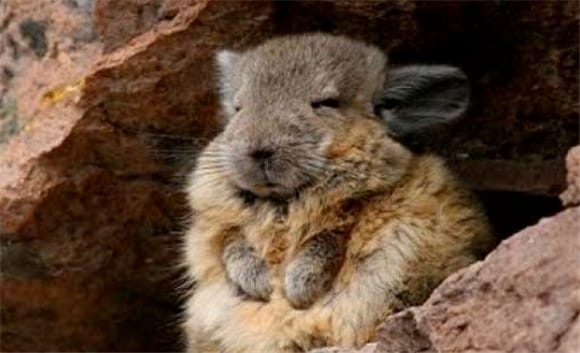There are many ways to understand something, but studying its history is indispensable.
01
Indian, Spanish
A long time ago, chinchillas and their second cousins lived in the Andes Mountains of South America. They lived in the crevices of the rocks. In the cave, you can sunbathe during the day and play Honor of Kings at night. Life is very comfortable.
What bad intentions could Xiao Zai Zai have?
Later, the Indians with feathers on their heads came. The Indians wanted to use chinchillas to make clothes, but the reason they gave was : The chinchilla dug holes in the ground, causing the war horses to trip frequently. The warriors of the tribe wanted to take righteous revenge... This made the rat and the hare laugh.

Many years passed in this way, and wherever the Indians arrived Large animals were exterminated everywhere. They realized the seriousness of the problem, began to domesticate animals and plants, and tried to get along with nature in a more friendly and peaceful way. Chinchillas once again had a short and comfortable life.
The Spanish came in 1500. They discovered chinchillas and named them "Chinchilla" after the local Indian tribe. The Spanish also coveted chinchilla fur, and chinchilla skins were shipped to Europe as gifts to royal members.
What humans are best at is imitation. Poor people imitate rich people, and rich people imitate nobles. In this way, by 1700, chinchilla fur became popular in Europe. More chinchillas are being killed under the trend of profit. By 1890, a man known as "My Neighbor Totoro" sold more than 300,000 hides in a few years.
In this case, My Neighbor Totoro was forced to play PlayerUnknown's Battlegrounds. It is estimated that over a million chinchillas were killed during this time alone. Finally, with chinchillas on the verge of extinction, South American governments finally banned trapping of chinchillas.
02
Meet Chapman
Chapman was a mining engineer working in Chile. One day in 1918, an Indian came to his camp, selling the chinchillas he caught. This chinchilla was squatting and chewing grass when suddenly a can fell from the sky. Then it felt dizzy and still can't figure out what happened. Chapman was attracted by the chinchilla's cute look and bought it. (PS: I seriously suspect that chinchillas often remain motionless because they have inherited the sequelae of being beaten)
Chapman and chinchilla Pete
Chapman observed the chinchilla whenever he had nothing to do. , watching it stay there motionless from time to time, jump back and forth from time to time, and even do some simple interactions. When feeding, it will even snatch the food from your hand. After getting familiar with it, it dares to play with you, which makes Chap Man was very interested in this little thing. So he thought about bringing chinchillas back to the United States to breed and start a pet business.
03
The original "11"
There are 3 different types of chinchillas in the Andes. The larger "short tail" is found at the base of the Andes, the smaller "long tail" is found high in the mountains, and the largest "imperial chinchilla" is found in the highest and most remote locations. Due to hundreds of years of hunting, the short-tailed chinchillas in the lower parts of the mountains are basically invisible, and the "emperor" is also extinct, so the only way to catch the long-tailed chinchillas is in high places.
Chapman knew that he could not do the job alone, so he hired some locals and made more than 20 traps. In order to capture chinchillas, they expanded the scope of their search and even used the enthusiasm of Interpol to catch chinchillas from Chile to Peru. Along the way, living conditions are difficult, supplies are very scarce, people are exhausted physically and mentally, and they age quickly, so you must never let chinchillas leave the house.
At that time, chinchillas were so rare that many people had never seen them, so the employees were not very professional, so many magical things happened. One time an employee returned to the camp and said he had caught a chinchilla. This man locked the chinchilla in an empty oil drum, put it on a donkey and walked for a month before returning. During the entire month, the employee did not even give the chinchilla a sip of water. Because in the minds of Indians, chinchillas are afraid of water and will die as soon as they drink water. Fortunately, when he caught the chinchilla, he saw the chinchilla chewing on a cactus, and he fed it cactus along the way, otherwise what he brought back would probably be a specimen.
Three years passed in this way, and Chapman only caught 11 chinchillas. These chinchillas were caught from different areas of the mountains, equivalent to different ethnic groups. And of these 11 chinchillas, only three are female.
The chinchillas you can see now are all descendants of these 11 animals.

Dona Inez Suez, one of the 11 chinchillas
03
Long-distance trek
Chinchillas live in high-altitude areas. In order to avoid adapting to the rapid changes in the environment, they have to spend several months going down the mountain. , so that chinchillas can slowly adapt to the low-altitude environment. They used wooden boards to build a cage for chinchillas to live in, and covered the top with denim to avoid direct sunlight during the day. This was the first "cabinet cage" in history.
At the same time, he applied to the Chilean government to take chinchillas out of customs. But chinchillas are protected animals, and the Chilean government rejected his application. After many applications, the Chilean government finally approved Totoro’s request to leave the country in 1923.
Customs Approval
Being able to ship out of Chile does not mean that it can be brought back to the United States. And "unknown species" are not allowed on public transportation, so Chapman and his friends put chinchillas in their pockets to avoid inspection. (PS: It turns out that someone did this 100 years ago). It was hot and stuffy on the boat, so the Chapmans took turns changing ice cubes in the cage, and put wet towels on the cage. The first "air-conditioned cage" in history was born.
They arrived in San Pedro on February 22, 1923. There were 12 chinchillas. One chinchilla died during the voyage. Fortunately, two cubs were born.
04
Despair
After returning to the United States, Chapman placed the chinchillas in Los Angeles while looking for a suitable breeding place. California has a vast desert , where the climate was very similar to the Alaskan Mountains, so farms were built there. But he discovered a problem. The chemical substances in the local spring water seriously exceeded the standard. He was afraid that this would cause harm to the chinchillas and even affect their fertility.
What is even more unfortunate is that someone actually came to steal the chinchilla, and half of the chinchilla was stolen. (PS: I have heard before that some people pretended to be buyers and went to the seller's house to steal chinchillas; others went to the seller's house to poison the chinchillas. It turns out that someone also did it 100 years ago). The farm was too unsafe, also due to its relatively remote location, so Chapman built a temporary fortress while looking for a new place to prevent anyone from stealing chinchillas again. You can see how tight the fortress is, and you know what he is thinking. What a meltdown.
After experiencing so many disappointments and losses, Chapman returned to the Los Angeles area, muttering to himself: If the land is more expensive, just be more expensive. The wilderness is too scary. After several changes, a suitable place was found and the farm was rebuilt. The first batch of houses were similar to the previous ones, but considering safety and resistance to temperature changes, bricks were better, so later houses were built with bricks.
05
Development
In the following years, they successively imported some chinchillas from South America in order to improve the quality. The early cages they made were divided into two parts, just like a zoo house. One part was an outdoor activity place. The open space was used for chinchillas to move around, and the single room was used for living. Later it evolved into a "dating cage", which looked like a parrot's nest, with two floors and passages.
At that time, most people didn’t know what chinchillas were. Some farms also wanted to join the team of breeding chinchillas. At that time, the franchise fee plus a pair of chinchillas was US$3,200. Calculated according to inflation, it is equivalent to US$160,000 (1.1 million RMB) today. By the mid-1960s, chinchillas began to be sold as pets, with each chinchilla usually priced at $100, equivalent to $800 today (5,600 yuan).
In the mid-19th century, chinchillas spread in the United States. More and more people are raising chinchillas, and people are crazy about this little thing. In order to improve the housing for chinchillas, many people start various magical DIYs. Perhaps because they have watched too much "Doraemon", some people let Totoro live in the closet, and some dismantled the company's filing cabinets. To this day, many businesses are still providing this kind of home dismantling service...
Later, chinchillas came to your home. Think about what they have experienced in the past 100 years. It is really not easy for chinchillas. If the ban was delayed, there would be no way to catch them; if they were surrendered by thieves at that time, If the light is eaten as a rabbit again, there will be no future development.
After Totoro left the Andes, the second cousin said that he was very lonely. Maybe this is life. People always have to grow up and go their separate ways. I hope that one day they can still play happily together. game.
So cherish this hard-won meeting~

 扫一扫微信交流
扫一扫微信交流
发布评论